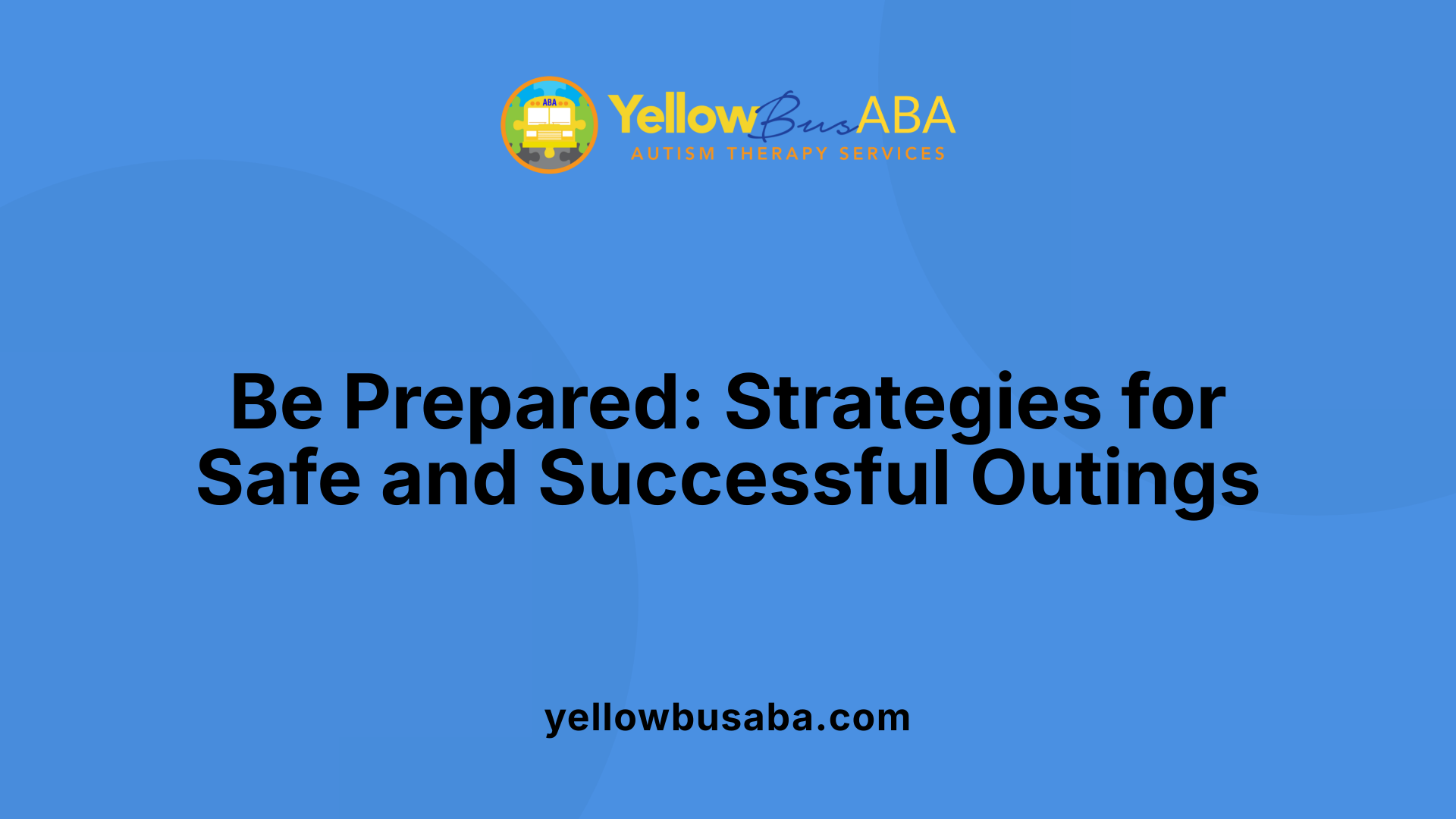Empowering Parents for Seamless Public Experiences
Public outings can be both rewarding and challenging for children with autism and their families. With the right application of ABA techniques and proactive planning, parents can foster positive experiences while supporting their child's development. This article explores effective strategies, preparation tips, and available resources to help families navigate community outings successfully.
Pre-Planning and Visual Supports for Successful Outings

How do visual schedules and social stories prepare children for outings?
Using visual schedules or social stories is a powerful way to help children understand what to expect during an outing. These visual tools break down activities into simple steps, reducing anxiety and confusion. For example, a mini schedule might include pictures of getting ready, riding in the car, arriving at the park, and engaging in activities. By reviewing these visuals beforehand, children gain a sense of predictability and control.
Visual supports like first-then cards or choice boards also give children choices and clarify expectations, which can boost motivation. These tools allow children to see what behavior is expected and what they will receive in return, fostering cooperation and compliance.
Furthermore, visual supports are easily customizable to fit each child's goals and preferences. They are especially helpful in scenarios where verbal instructions might not be understood or processed quickly, ensuring that children feel more secure and engaged.
How does priming with social stories and role-playing help prepare children?
Priming involves actively preparing a child for an upcoming outing by discussing what will happen and practicing relevant behaviors. Social stories are narrative-based visuals that describe social situations, such as visiting a restaurant or riding in a bus. They provide detailed yet understandable information, helping children grasp the sequence of events and appropriate responses.
Role-playing complements social stories by simulating real-life joint activities in a controlled setting. For example, parents and children can practice greeting staff, waiting in line, or sharing toys. Role-playing allows children to rehearse social cues and behaviors in a safe space, reducing anxiety when they encounter similar situations during actual outings.
Together, social stories and role-playing boost confidence, improve understanding, and prepare children socially and emotionally for community experiences.
Why is providing short, clear instructions important?
Clear and concise instructions are crucial in public settings where distractions are common. Short commands like "Hold my hand," or "Sit quietly," are easier for children to process and follow. Using simple language minimizes confusion and increases the likelihood of compliance.
When giving instructions, it’s beneficial to use a calm tone, wait for the child to respond, and provide positive reinforcement for following through. Repetition and consistency reinforce learning, helping children internalize routines and behaviors.
In addition, providing only one instruction at a time prevents overwhelm. This approach ensures that children focus on one task, making transitions and daily activities smoother. Combining visual supports with short instructions further enhances understanding and cooperation, creating a positive outing experience for both children and parents.
Using Transitional Supports to Ease Movement and Environmental Changes
 First-Then statements and visual cues are highly effective tools for creating predictability in public outings. These strategies help children understand what to expect next, reducing anxiety and promoting cooperation. Visual supports like mini schedules, first-then cards, or choice boards visually depict the sequence of activities, making the experience clearer.
First-Then statements and visual cues are highly effective tools for creating predictability in public outings. These strategies help children understand what to expect next, reducing anxiety and promoting cooperation. Visual supports like mini schedules, first-then cards, or choice boards visually depict the sequence of activities, making the experience clearer.
Transition objects such as favorite toys or sensory items provide comfort and aid in self-regulation, helping children feel secure during transitions. Additionally, timers and countdowns serve as pre-transition warnings, giving children a clear indication of when a change will occur. This advance notice allows them to prepare mentally and physically, easing the transition.
Strategies like applying ABA techniques involve setting clear expectations, using immediate reinforcement for positive behaviors, and preparing children with social stories or role-playing scenarios before outings. Reflecting on each event helps identify what went well and what needs adjustment, fostering continuous improvement.
Parents can enhance their approach by seeking support from local ABA providers who offer tailored, community-based training. These professionals can guide the implementation of effective transition supports, including visual cues, reinforcement strategies, and communication methods.
To summarize, combining visual supports, transition objects, timers, and social stories creates a structured environment that reduces anxiety and encourages positive behavior during outings. This comprehensive approach allows children to navigate public settings more confidently and comfortably.
Fostering Social Skills and Positive Interactions in Public

How can parents effectively manage their child's behavior with autism during community outings?
Managing behavior during outings involves a combination of strategies aimed at promoting understanding and reducing anxiety. For example, using visual supports such as mini schedules, first-then cards, or choice boards can help children understand what to expect. Setting clear behavioral expectations beforehand, along with defined rewards and consequences, establishes boundaries and helps children know what is appropriate.
Immediate reinforcement of positive actions, such as praising when a child holds hands or follows directions, encourages continued cooperation. When challenging behaviors occur, staying calm, redirecting, and employing functional communication support are essential. In such moments, having a plan for escalation—like using calming strategies or providing a designated safe space—can facilitate a quick recovery.
Regularly reflecting on outings—what worked and what didn’t—allows parents to adjust strategies effectively. Additionally, seeking ongoing support from professionals like Board Certified Behavior Analysts (BCBAs) can help tailor specific interventions suited to each child, ensuring safer and more enjoyable community experiences.
Responding to Challenging Behaviors and Ensuring Safety
 When managing children with autism in public settings, applying ABA (Applied Behavior Analysis) techniques can significantly enhance safety and positive interactions. One essential strategy is to stay calm, as children often mirror adult emotions. Redirecting problematic behaviors by offering alternative activities or choices helps reduce disruptions and promotes cooperation.
When managing children with autism in public settings, applying ABA (Applied Behavior Analysis) techniques can significantly enhance safety and positive interactions. One essential strategy is to stay calm, as children often mirror adult emotions. Redirecting problematic behaviors by offering alternative activities or choices helps reduce disruptions and promotes cooperation.
Functional Communication Training (FCT) is crucial for enabling children to express their needs appropriately. By teaching children to use gestures, words, or communication devices, parents can replace challenging behaviors with effective communication signals, reducing frustration and improving compliance.
Having a plan for escalation and calming is vital. This includes identifying triggers that might lead to meltdowns, and preparing calming tools or safe spaces where the child can self-regulate. Implementing calming strategies early can prevent escalation and support quicker recovery from challenging behaviors.
Effective application of ABA during outings also involves establishing clear expectations beforehand. Visual supports like social stories, visual schedules, and choice boards can prepare children for what to expect, easing anxiety and fostering understanding. Reinforcing positive behaviors immediately with preferred reinforcers encourages ongoing compliance.
When difficulties arise, minimizing attention to problem behaviors can be beneficial. Instead, focus on redirecting and using praise for desired behaviors such as holding hands or following directions. This approach reduces the likelihood of reinforcement for challenging conduct.
Planning for safety is also essential. Parents should have a plan for handling emergencies, including calm, supportive responses and knowing when to seek additional help. Regular reflection on each outing can help identify what worked well and what needs adjustment, leading to more successful future outings.
Parents are encouraged to seek ongoing support from qualified professionals like Board Certified Behavior Analysts (BCBAs). They can help develop individualized strategies, provide training, and offer community-based resources in Atlanta, Georgia, or elsewhere, ensuring tailored support that promotes safety, learning, and positive experiences during public outings.
Building Confidence and Success in Community Outings
By incorporating evidence-based ABA strategies, preparing children through visual supports and social stories, and utilizing community resources, parents can enhance their child's ability to navigate public outings successfully. Reflecting on each experience and seeking ongoing support ensure progress and confidence for both parents and children, fostering positive lifelong skills and social connections.
References
- How to Use ABA Strategies in Public Settings
- Navigating Community Outings: Strategies for Success
- Reducing Problem Behaviors in Public: ABA Tools for Real-World ...
- How to Use ABA Strategies in Public Settings
- ABA Training for Parents Online Course - Relias Academy
- Reducing Problem Behaviors in Public: ABA Tools for Real-World ...
- Community Based ABA Therapy - Bluesprig Autism
- 10 Ways Applied Behavior Analysis Can Improve Your Child's Life



.jpg)

.avif)
